#Messelastur
Explore tagged Tumblr posts
Text

Old Messelastur gratulator commission. By Christopher Rigobello.
103 notes
·
View notes
Text
Fossil Novembirb: Day 8 - Raptors Are Back

Once the Cenozoic had begun, the only remaining dinosaurs were modern birds. That means raptors (or dromaeosaurs) would never again stalk the Earth, right? Wrong! Raptor dinosaurs get their name from modern raptors: eagles, hawks, owls and the like; and they are in fact some of the closest relatives of birds. So during the Paleogene period when predatory birds started to radiate, they weren't reinventing being a raptor. They continued being raptors.
Palaeoglaux: An early owl from Germany's Messel Lake, about 40 million years ago. Unlike modern owls, it had strange ribbon-like feathers on its body, likely used in display.
Horusornis: A strange relative of hawks and eagles that lived in France 35 million years ago. Like modern harrier-hawks, it had flexible feet to dig out prey from tree cavities.
Antarctoboenus: An early relative of falcons found from Antarctica, about 35 million years ago. It may have prowled near the edges of giant penguin colonies.
Danielsraptor: Another early falcon from the 50 million year old London Clay formation. It had a large jagged beak and long legs, which helped it catch prey on the ground.
Dynamopterus: A relative of Seriemas and terror birds from Messel lake, about 40 million years ago. It likely caught small vertebrates from the forest floor.
Paleopsilopterus: One of the earliest known terror birds, it lived in Brazil about 50 million years ago. It was already flightless and similar to later small terror birds.
Bathornis: A distant relative of terror birds that was remarkably successful. This flightless predator and its relatives lived in North America from the Late Eocene to the Oligocene.
Messelastur: A falcon-like bird of prey that was closely related to parrots and passerines instead of raptors. It lived in Messel Lake about 40 million years ago.
Masillaraptor: A tiny true falcon also known from Messel Lake. It had a relatively long beak from a falcon, and it may have fed mostly on large insects.
Tynskya: Another small raptor related to parrots and passerines, this falcon-like predator lived around 50 million years ago. Its remains have been found in North America and Europe.
#Fossil Novembirb#Novembirb#Dinovember#birblr#palaeoblr#Birds#Dinosaurs#Cenozoic Birds#Palaeoglaux#Horusornis#Antarctoboenus#Danielsraptor#Dynamopterus#Paleopsilopterus#Bathornis#Messelastur#Masillaraptor#Tynskya
79 notes
·
View notes
Text

Messelastur
Messelastur — викопний рід птахів родини Messelasturidae, щодо систематичного положення якої ведуться суперечки. Рід існував у еоцені (48-40 млн років тому). Голотип (номер SMF-ME 2024) знайдений у кар’єрі Мессель у Німеччині. Він складається з неповного черепа та 15 хребців. Типовий вид — Messelastur gratulator.
Повний текст на сайті "Вимерлий світ":
https://extinctworld.in.ua/messelastur/
#messelastur#bird#eocene#deutschland#germany#messelasturidae#paleontology#paleoart#prehistoric#animals#prehistory#science#article#illustration#daily#animal art#digital art#extinct#палеоарт#палеонтологія#ukraine#ukrainian#art#мова#україна#українська мова#ua#птахи#німеччина#український тамблер
6 notes
·
View notes
Photo
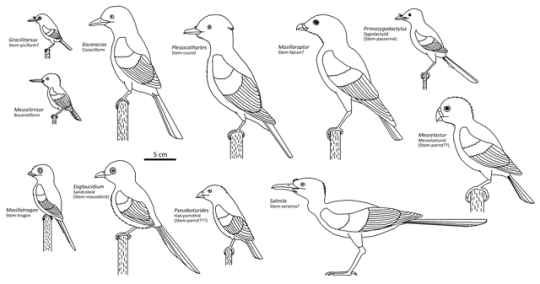
After forests recovered from their devastation by the Cretaceous mass extinction 66 million years ago, the few surviving dinosaurs quickly radiated into vacant arboreal niches. Among these new tree-dwelling birds, the most diverse were members of the clade Telluraves, a group that would give rise to hawks, owls, hornbills, kingfishers, woodpeckers, falcons, parrots, songbirds, and many more.
Here are a few 47-million-year-old telluravians whose fossils were found in the Messel Shale of Germany.
#Birds#Dinosaurs#Palaeoblr#Telluravians#Messelirissor#Gracilitarsus#Eocoracias#Masillatrogon#Eoglaucidium#Pseudasturides#Plesiocathartes#Masillaraptor#Salmila#Messelastur#Primozygodactylus
19 notes
·
View notes
Text
Eocoracias brachyptera
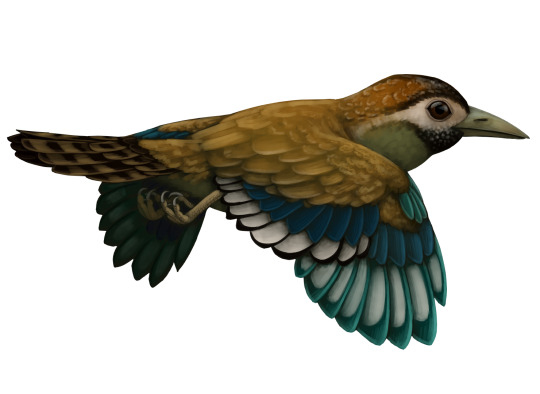
By Scott Reid
Etymology: Dawn Near Crow
First Described By: Mayr & Mourer-Chauvire, 2000
Classification: Dinosauromorpha, Dinosauriformes, Dracohors, Dinosauria, Saurischia, Eusaurischia, Theropoda, Neotheropoda, Averostra, Tetanurae, Orionides, Avetheropoda, Coelurosauria, Tyrannoraptora, Maniraptoromorpha, Maniraptoriformes, Maniraptora, Pennaraptora, Paraves, Eumaniraptora, Averaptora, Avialae, Euavialae, Avebrevicauda, Pygostaylia, Ornithothoraces, Euornithes, Ornithuromorpha, Ornithurae, Neornithes, Neognathae, Neoaves, Inopinaves, Telluraves, Afroaves, Coraciimorphae, Cavitaves, Eucavitaves, Picocoraciae, Picodynastornithes, Coraciiformes, Eocoraciidae
Status: Extinct
Time and Place: 48 million years ago, in the Ypresian age of the Eocene of the Paleogene

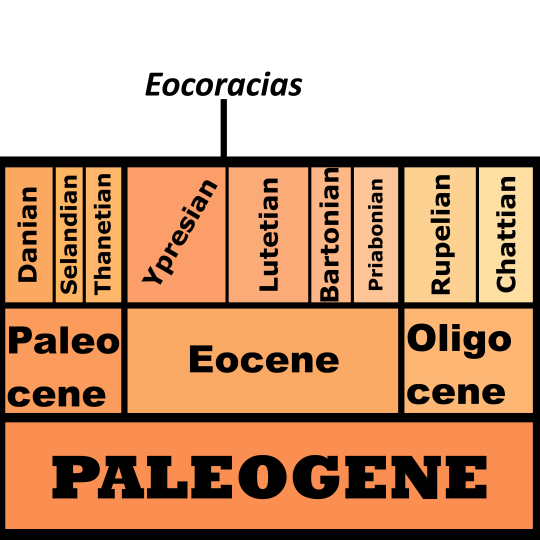
Eocoracias was found in the Messel Pit formation of Darmstadt-Dieburg, Germany
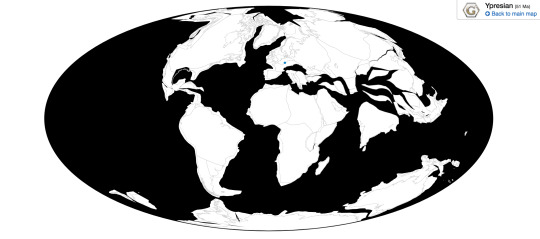
Physical Description: Eocoracias was an early, transitional relative of modern rollers - a group of predatory, tree-dwelling birds that often feature bright, distinctive colors and patterns in their feathers. Eocoracias itself resembled rollers and their closest relatives alike, showcasing how this group of birds evolved (rollers being closely related to animals such as kingfishers). Overall, it looked a lot like modern rollers - it had a large head compared to the rest of its body, a relatively rectangular front of the head, though its eyes were not developed quite the same as modern roller eyes. In addition, its skull wasn’t quite as long and thin as modern rollers, though it did have as robust a beak as its living relatives. It had smaller toe bones than other rollers, though it is unlikely that this would have translated to it being less arboreal than its modern relatives. This is corroborated by the fact that its legs were somewhat short, though still similar to living rollers. It also had shorter wings than living members of the group, as well as long tail feathers, similar to modern Ground Rollers. In overall size, it was about the same size as a modern jay - around 35 centimeters in length, so a little bigger than most modern rollers.
Diet: Unlike its modern relatives, Eocoracias was not exclusively a meat-eater; instead, seeds have been found in its stomach in addition to animal material, indicating that Eocoracias was more of a generalized feeder. As an omnivore, it would have fed upon seeds, insects, fruit, and maybe even small vertebrates.
Behavior: Though Eocoracias was probably more closely related to modern Rollers, its overall body shape actually resembled Ground Rollers more closely. As such, it might have had a more similar lifestyle to Ground Rollers than to Rollers. Its short, triangular wings would have been useful in more short bursts of flight and agile maneuvering; its sturdier legs meant that, though it was still arboreal, it probably spent more time on the ground than modern rollers. In addition, it may have even nested in holes on the ground, rather than holes in trees like modern Rollers.
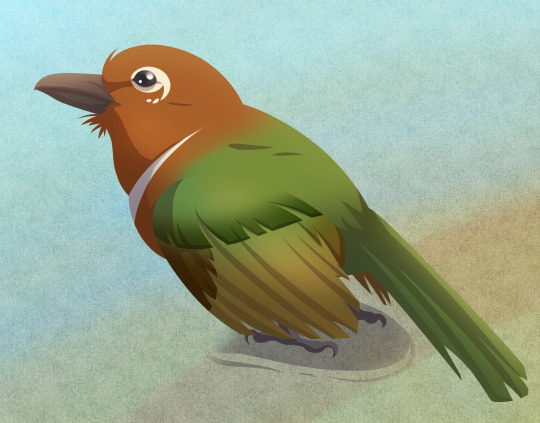
By José Carlos Cortés
Ecosystem: The Messel Pit was an extremely diverse and important ecosystem from the middle of the Eocene, showcasing how life began to transition into modern forms. Precursors of modern mammals and birds are common in the fossils from the Messel Pit, as well as other groups of animals such as insects, fish, and reptiles; in addition, plants showcase the unique climate and environment of the planet at this time. This environment was during the Global Rainforest period of the first half of the Eocene, in which the world was warm and wet, and covered with rainforest environments. The Messel Pit environment was no different; the area that the fossils represent was a large lake, surrounded by an extensive forest ecosystem. Volcanic gases were also common within the lake, which would have overwhelmed the animals living around it and caused mass deaths, allowing their bodies to fall into the lake and leading to their exceptional preservation.
Though it’s impossible to list all the animals that lived alongside Eocoracias, some notable dinosaurs that also lived in the Messel Pit along with Eocoracias include other Coraciiformes like Messelirrisor and Primobucco. The early relative of songbirds, Primozygodactylus, was a common feature in the area. The parrot of prey Messelastur was also present, as was the early seriema-like Strigogyps and the tiny owl Palaeoglaux. Early primates, rodents, bats, horses, and Leptictidium also lived in the area. Though it wasn’t found with it, Gastornis also probably would have frequented the environment of Eocoracias, though since Gastornis fed upon fruit, it wouldn’t have eaten Eocoracias. Instead, Messelastur and Strigogyps might have been main the predators of Eocoracias.
Interestingly enough, though this was an intensely forested environment, none of the tree-dwelling birds got as large as modern crows; this was probably due to the density of the vegetation.
Other: Eocoracias is known from multiple individuals, indicating it was fairly common within the Messel ecosystem.
~ By Meig Dickson
Sources under the cut
Mayr, G., C. Mourer-Chauviré. 2000. Rollers (Aves: Coraciiformes s.s.) from the Middle Eocene of Messel (germany) and Upper Eocene of the Quercy (France). Journal of Vertebrate Paleontology 20 (3): 533 - 546.
Mayr, G. 2009. Paleogene Fossil Birds. Springer-Verlag Berlin Heidelberg.
Mayr, G. 2016. The early Eocene birds of the Messel fossil site: a 48 million-year-old bird community adds a temporal perspective to the evolution of tropical avifaunas. Biological Reviews 92 (2): 1174 - 1188.
Mezger, J. E., M. Felder, F.-J. Harms. 2013. Crystalline rocks in the maar deposits of Messel: key to understanding the geometries of the Messel Fault Zone and didatreme and the post-eruptional development of the basin fill. Journal of the German Geosciences Society 164 (4): 639 - 662.
#eocoracias#dinosaur#bird#roller#omnivore#paleogene#eurasia#palaeoblr#birblr#factfile#afroavian#coraciiform#eocoracias brachyptera#birds#dinosaurs#paleontology#prehistory#prehistoric life#biology#a dinosaur a day#a-dinosaur-a-day#dinosaur of the day#dinosaur-of-the-day#science#nature
206 notes
·
View notes
Text
Palaeoglaux
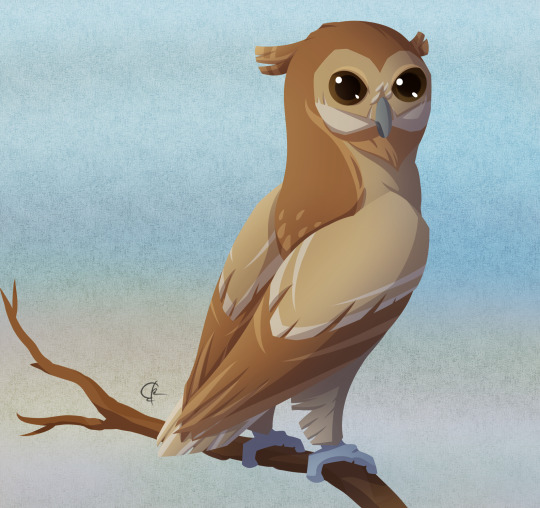
By José Carlos Cortés
Etymology: Ancient Owl
First Described By: Mourer-Chauviré, 1987
Classification: Dinosauromorpha, Dinosauriformes, Dracohors, Dinosauria, Saurischia, Eusaurischia, Theropoda, Neotheropoda, Averostra, Tetanurae, Orionides, Avetheropoda, Coelurosauria, Tyrannoraptora, Maniraptoromorpha, Maniraptoriformes, Maniraptora, Pennaraptora, Paraves, Eumaniraptora, Averaptora, Avialae, Euavialae, Avebrevicauda, Pygostaylia, Ornithothoraces, Euornithes, Ornithuromorpha, Ornithurae, Neornithes, Neognathae, Neoaves, Inopinaves, Telluraves, Afroaves, Strigiformes
Referred Species: P. perrierensis, P. artophoron
Status: Extinct
Time and Place: Palaeoglaux lived from 48 to 37 million years ago, from the Ypresian age to the Priabonian age of the Eocene in the Paleogene

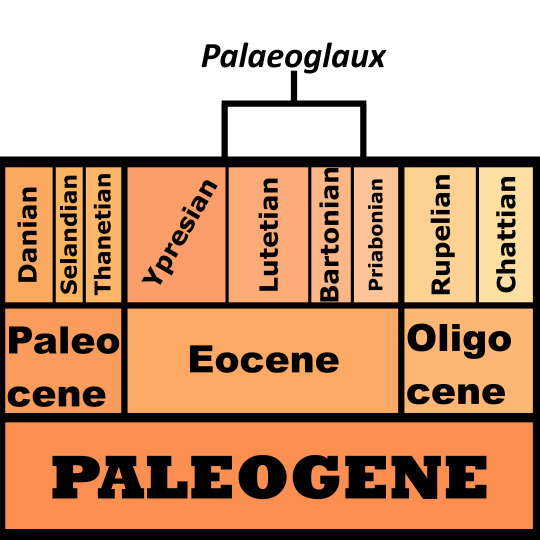
Palaeoglaux is known from the Messel Pit of Darmstadt-Dieburg, Germany; as well as the later Quercy Fissure Formation of Occitanie, France
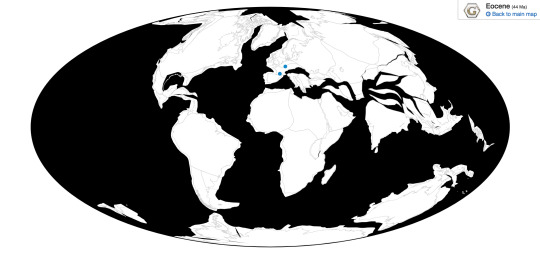
Physical Description: Palaeoglaux was a very early form of owl, and one of the most complete early owls known - which means we know quite a bit about it! It is known from multiple individuals, including full skeletons on slabs; though, at this time, its skull is not known, so it is uncertain if it looked quite as weird as living owls in terms of facial structure. Like living owls, it has extra air holes in its shoulders, showing that this unique trait of living owls evolved very early on. However, it doesn’t show a bony arch in the foot like living owls, meaning it probably didn’t use its feet as much in hunting as living owls do - since that bony arch helps to strengthen the feet in gathering prey.
In general, Palaeoglaux was a fairly small owl, about the size of the modern Little Owl - so, able to fit in the palm of the hand. This makes sense, given that most animals from the global rainforest of the Messel Pit were quite small, due to the density of vegetation. In addition, the later species - from the late Eocene, when the rainforest was transitioning to drier, more open environments - is significantly larger than the earlier species, thus pointing to its size being directly related to its environment. One distinctive thing about Palaeoglaux, at least the earlier Messel species, are its feathers - long, ribbon like feathers are known from its back, which were originally interpreted as display structures. This would have made Palaeoglaux a rare, but not unique, example of a diurnal (daytime) owl. However, these sorts of feathers are actually quite common in Messel Pit fossils - so it actually could be an example of a preservational thing. Thus, more fossils are necessary to determine if these feathers are actually a display structure or just regular old feathers. Since there are many diurnal birds of prey in the Messel Environment, it would make sense for there to be at least one nighttime hunter such as Palaeoglaux. Still, the jury is out.
Diet: As an owl, Palaeoglaux was probably a bird of prey - feeding on small animals such as rodents, lizards, and smaller birds. Still, we do not have the head of Palaeoglaux at this time; this means we can’t be certain that it was exclusively carnivorous, like modern owls. It is more likely because the common ancestor of owls and many other birds such as mousebirds, rollers, parrots, and songbirds was probably a bird of prey; so owls (and animals like hawks, eagles, falcons, and seriemas) just retained that lifestyle while other groups lost it. Still, it’s possible Palaeoglaux may have had a different diet than living owls, and more fossils are necessary to confirm that it was a predator. Given that Palaeoglaux was quite small in the Messel environment, it wouldn’t have been able to eat very big animals; though its prey size would have increased as it did later in the Eocene.
Behavior: Owls today utilize keen eyesight and hearing to hunt food at night, using silent flight to sneak up on prey and catch them unawares. Many of the features necessary for this probably evolved in the Eocene, as some of the earliest representatives of modern owls evolved in this time. However, Palaeoglaux shows a unique mixture of early and derived traits, and thus, it may not have been ask exceptionally adapted for hunting as living owls. Much of Palaeoglaux’s behavior remains a mystery because we do not have fossils of its head at this time - and we’re not sure whether or not it was diurnal, meaning active in the day, or nocturnal, aka active at night.
Given that it does have more air-filled shoulder bones, it probably was in the process - if not already there - of evolving those silent flight mechanics of living owls. This would have aided it in hunting prey, allowing it to sneak up on other animals. However, its less strengthened toe bones would mean that it wasn’t quite as good at holding down its prey and catching it with its feet as living owls; it possible that it would have used its mouth more, though of course, without head fossils that’s difficult to say. Still, it would have dwelled in trees, using its high vantage point to look for food.
If Palaeoglaux’s ribbon feathers were for display, rather than just regular feathers, then Palaeoglaux would have probably been diurnal - active and hunting during the day. It may have puffed up those ribbon feathers in threat displays or sexual displays as well. If they weren’t for display, Palaeoglaux may have still been diurnal; or it could have been nocturnal, hunting small animals at night.
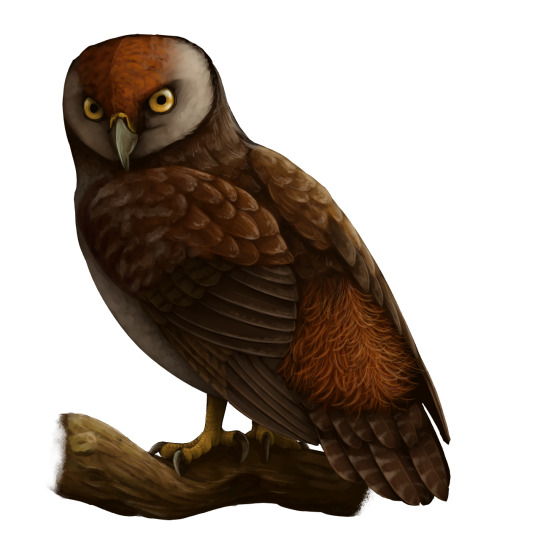
By Scott Reid
Ecosystem: The Messel Pit was a diverse and important ecosystem from the middle Eocene, with many different transitional forms of animals to showcase how life began to evolve into modern forms. Palaeoglaux is one of many transitional dinosaurs, living in the Global Rainforest environment of the time; the Messel Pit was warm and wet and covered with dense vegetation, which rendered Palaeoglaux and essentially all other tree-dwelling birds extremely small. The forest surrounded a large lake, which was filled with trapped volcanic gas; these gases would have released periodically and overwhelmed the animals of the environment, leading ot mass deaths. These animals would have then drifted down to the bottom of the lake, allowing for the unique preservation that allows for us to have a unique glimpse into this environment. Palaeoglaux probably spent most of its time in the trees, rather than closer to the lakeshore.
Many other dinosaurs filled the environment with Palaeoglaux, including the early roller Eocoracias, the early songbird Primozygodactlyus, other roller and Kingfisher relatives Messelirrisor and Primobucco, the parrot of prey Messelastur, the seriema-like Strigogyps, and the large herbivore Gastornis. Messelastur and Strigogyps, being much, much larger than Palaeoglaux, may have even fed upon it. The early flamingo relative Juncitarsus was also present in the pit, and probably was a wading bird within the lake of the Messel. Early forms of hummingbirds and other weird fliers were present (such as early relatives of potoos and nightjars), as well as an early woodpecker relative Gracilitarsus, other seriema relatives like Idiornis, and falcons like Masillaraptor. As such, diurnal birds of prey were heavily present in the Messel; and this points more to Palaeoglaux potentially being nocturnal after all.
Palaeoglaux was also present in the Quercy Fissure Formation. This was a later Eocene formation, showcasing how life began to transition along with the general environment. The global rainforest was drying up as the world was cooling; ice caps were forming at the poles, and ecosystems in general were becoming more open, dry plains. As such, Palaeoglaux got somewhat larger - as did other birds. Still, the Quercy Formation represents an environment that was still fairly warm and wet - it was probably an estuary environment, near to the shore but not quite associated fully, given that very few fish are preserved there. The environment was littered sinkholes and caves, leading to its unique preservation of animals. Many salamanders and some frogs are known form the area; though, by far, lizards are some of the most common animals there, and were probably a major source of food for Palaeoglaux. Here, Strigogyps was still present, and may have still been a problem for Palaeoglaux; parrots closer to modern forms such as Quercypsitta were present, as was the early woodpecker relative Sylphornis. Pigeons, water birds, and landfowl were also common frequenters of this environment.
Other: Palaeoglaux, though complete, is often extremely crushed; the fossil slabs of the species are difficult to interpret, and one of the best known slabs has not yet been fully described.
Species Differences: P. perrierensis is the later species from Quercy - so it is younger, from France, and larger than P. artophoron, the species from the Messel. In addition, P. perrierensis did have somewhat stronger feet than P. artophoron, indicating further evolution of traits involved in catching prey as the genus continued through the Eocene.
~ By Meig Dickson
Sources under the cut
Astruc, J. G., G. Escarguel, B. Marandat, R. Simon-Coinçon, B. Sigé. 2000. Floor-age constraining of a tectonic paroxysm of the Pyrenean orogen. Late Middle Eocene mammal age of a faulted karstic filling of the Quercy phosphorites, south-western France. Geodinamica Acta 13: 271 - 280.
Mayr, G. 2009. Paleogene Fossil Birds. Springer-Verlag Berlin Heidelberg.
Mayr, G. 2017. Avian Evolution: The Fossil Record of Birds and its Paleobiological Significance. Topics in Paleobiology, Wiley Blackwell. West Sussex.
Mayr, G. 2016. The early Eocene birds of the Messel fossil site: a 48 million-year-old bird community adds a temporal perspective to the evolution of tropical avifaunas. Biological Reviews 92 (2): 1174 - 1188.
Mezger, J. E., M. Felder, F.-J. Harms. 2013. Crystalline rocks in the maar deposits of Messel: key to understanding the geometries of the Messel Fault Zone and didatreme and the post-eruptional development of the basin fill. Journal of the German Geosciences Society 164 (4): 639 - 662.
Mourer-Chauviré, C. 1987. The owls (Aves: strigiformes) of Phosphorites Du Quercy (France) systematics, biostratigraphy, and paleobiogeogrpahy, pgs 89 - 136 in Documents des Laboratoires de Geologie Lyon, Départment des Sciences de la Terre, Université Claude-Bernard Lyon 1.
Peters, D. S. 1992. A new species of owl (Aves: Strigiformes) from the Middle Eocene Messel Oil Shale. Campbell, K. ed. Papers in Avian Paleontology honoring Pierce Brodkorb. Science Series Natural History Museum of Los Angeles County 36: 161 - 169.
Rage, J.-C. 2006. The Lower Vertebrates from the Eocene and Oligocene of the Phosphorites du Quercy (France): An Overview. Strata 1 (13): 161 - 173.
#palaeoglaux#bird#dinosaur#owl#paleogene#carnivore#eurasia#theropod thursday#birds#dinosaurs#afroart#factfile#birblr#palaeoblr#palaeoglaux perrierensis#palaeoglaux artophoron#paleontology#prehistory#prehistoric life#biology#a dinosaur a day#a-dinosaur-a-day#dinosaur of the day#dinosaur-of-the-day#science#nature
177 notes
·
View notes
Text
Messelastur gratulator

By Jack Wood on @thewoodparable
PLEASE SUPPORT US ON PATREON. EACH and EVERY DONATION helps to keep this blog running! Any amount, even ONE DOLLAR is APPRECIATED! IF YOU ENJOY THIS CONTENT, please CONSIDER DONATING!
Name: Messelastur gratulator
Status: Extinct
First Described: 1994
Described By: Peters
Classification: Dinosauria, Theropoda, Neotheropoda, Averostra, Tetanurae, Orionides, Avetheropoda, Coelurosauria, Tyrannoraptora, Maniraptoriformes, Maniraptora, Pennaraptora, Paraves, Eumaniraptora, Averaptora, Avialae, Euavialae, Avebrevicauda, Pygostylia, Ornithothoraces, Euornithes, Ornithuromorpha, Ornithurae, Neornithes, Neognathae, Neoaves, Australaves, Psittacopasserae, Psittaciformes
Messelastur is yet another of our parrots - of - prey, specifically from the Messel pit of Germany, living about 48 million years ago, in the Ypresian age of the Eocene of the Paleogene. Closely related to Tynskya from yesterday, Messelastur was slightly larger, known from an incomplete skeleton and two skulls. It, like Tynskya, had a falcon-like head, and it had legs much like owls and falcons, despite being a close relative of modern parrots.
Sources:
https://en.wikipedia.org/wiki/Messelasturidae
Mayr, G. 2009. Paleogene Fossil Birds. Springer-Verlag Berlin Heidelberg.
http://fossilworks.org/bridge.pl?a=taxonInfo&taxon_no=137231
#messelastur#messelastur gratulator#bird#parrot#dinosaur#birblr#palaeoblr#paleontology#prehistory#prehistoric life#dinosaurs#biology#a dinosaur a day#a-dinosaur-a-day#dinosaur of the day#dinosaur-of-the-day#science#nature#factfile#Dìneasar#דינוזאור#डायनासोर#ديناصور#ডাইনোসর#risaeðla#ڈایناسور#deinosor#恐龍#恐龙#динозавр
63 notes
·
View notes